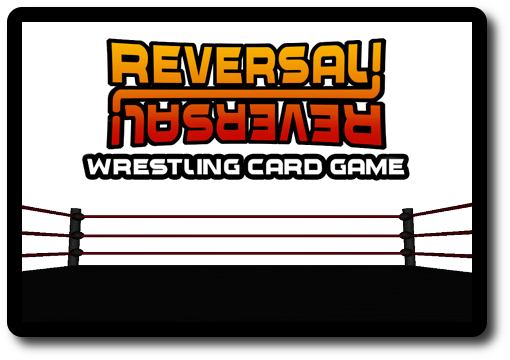
The Basics:
- For ages 8 and up
- For 2 players
- Approximately 20 minutes to complete
Geek Skills:
- Counting & Math
- Logical & Critical Decision Making
- Reading
- Pattern/Color Matching
- Strategy & Tactics
- Hand/Resource Management
Learning Curve:
- Child – Easy
- Adult – Easy
Theme & Narrative:
- Rule the ring to claim the belt!
Endorsements:
- Gamer Geek mixed!
- Parent Geek approved!
- Child Geek approved!
Overview
Former professional wrestler, actor, political commentator, author, naval veteran, and politician, Jesse Ventura said, “Wrestling is ballet with violence.” I could not agree more. The men and women who wrestle in the ring perform tremendous feats of strength and endurance, all timed and rehearsed to depict seemingly violent acts. Wrestlers are a mix of actors and athletes that put on shows where the danger of being hurt is very real, but that’s all part of the allure.
Reversal!, designed by Simon Marshall and published by Smoog Games via the Game Crafter, is comprised of 68 cards. The cards are as thick and as durable as your standard playing card. The illustrations are clean and depict various wrestling moves and the wrestlers who perform them.
In the Gym
To be a competent wrestler in real life, you must be disciplined and train constantly. Since this is just a card game, players only need to sit at a table and understand how the game is played. Which is, in a way, a form of discipline and training.
No, not really.
There are six different types of cards in Reversal! Each are introduced and summarized here.
Title Belt Cards
The Title Belt cards represent the specific competitive titles the players are attempting to win. The Title Belt cards also designate the rank of the title to be won (for example, “Heavyweight Champion”) and the number of wrestlers competing at one time (for example, “World Tag Team Champions”).
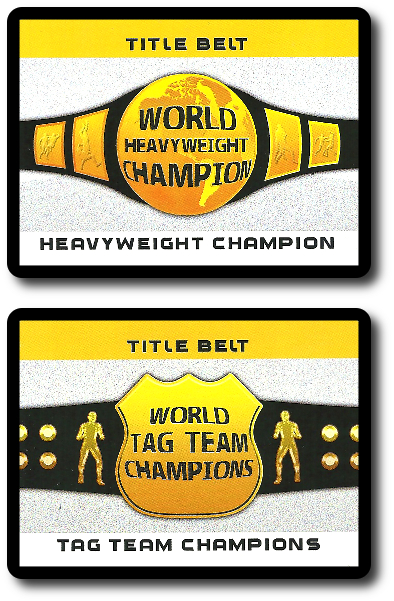
Wrestler Cards
The Wrestler cards represent the individuals who will be competing for the Title Belt cards on the player’s behalf. Each Wrestler card has 3 important piece of information.
- Name: Not used within the game, but it’s fun to announce the wrestlers by name when they win (or horribly lose).
- Power: Think of Power as “health”. If the wrestler takes enough damage, they will collapse in the ring.
- Finishing Move: Match a Move card with a wrestler’s special move for double the damage.
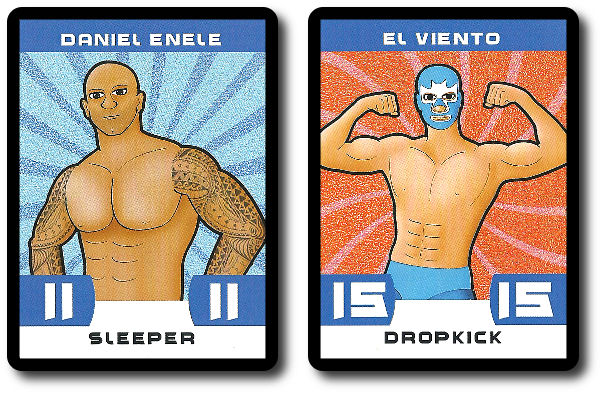
Move Cards
The Move cards represent the many different wrestling techniques that are used in the ring. These cards depict specific wrestling holds, kicks, jabs, jumps, and slams. Each Move card has 3 important pieces of information.
- Name: The name of the move is listed at the bottom. Players can attempt to match the move to their wrestler to create a special finishing move.
- Damage: Damage is listed as number values. Damage is cumulative in a Bout stack.
- Allowed Modifiers: Each Move card can be modified no more than once, but only if the Move card lists the Modifier card (noted in the green circles between the Damage value).
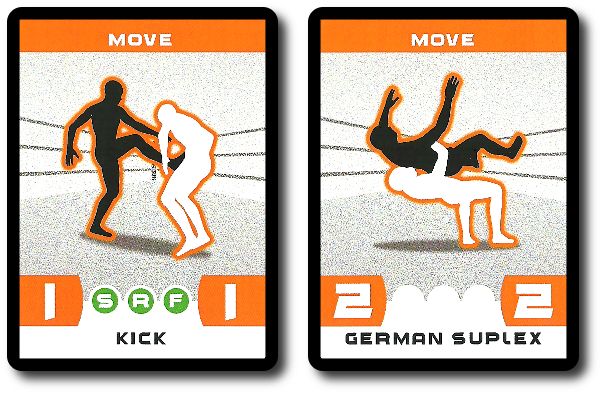
The “Kick” Move card can be modified with a “Spinning”, “Running” or “Flying” Modifier card, while the “German Suplex” Move card cannot be modified at all
Modifier Cards
The Move cards represent the standard fare you’d see in most wrestling matches. The Modifier cards take the Move cards and give them a boost, turning them into attacks with flair! For example, the “Flying Leg Drop”, which is always a crowd-pleaser. Each Modifier card has 2 important pieces of information.
- Name: Match the name (and noted letter in the green circle) to a Move card.
- Damage Bonus: The additional damage the modifier provides is added to the Move card it’s attached to.
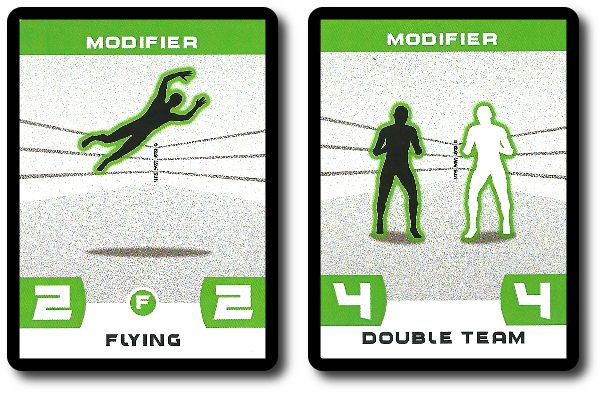
There are a few Modifier cards that can only be used in a Tag Team match
Block Cards
Wresting is as much about attacking your opponent as it’s defending against your opponent’s attacks. The Block cards represent defensive moves, as well as the wrestler’s will to keep fighting after taking a pummeling. Each Block card has 1 important piece of information.
- Damage Blocked: Block cards will cancel out the damage inflicted by Move and Modifier cards, but only if they are strong enough.
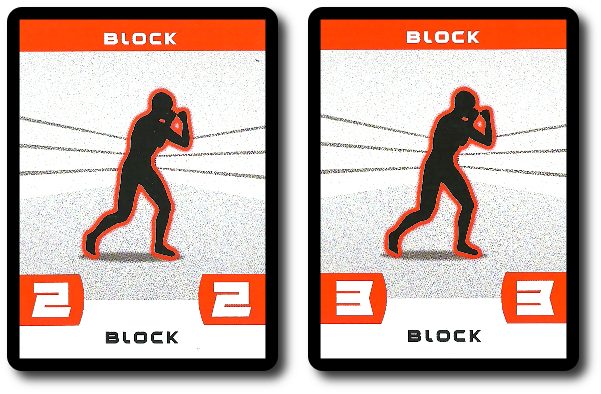
Reversal Cards
The Reversal cards represent those rare and spectacular moments when a wrestler is about to lose, but somehow manages to turn the tables on their opponent and come back with a vengeance.
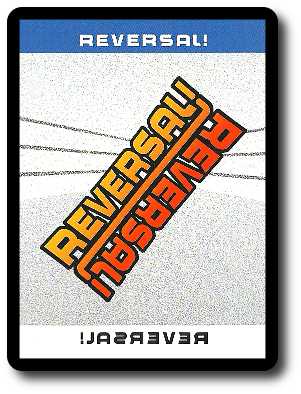
Warming Up
To set up the game, first separate from the deck the Title Belt and Wrestler cards. You should now have 3 piles of cards (1 Title Belt pile, 1 Wrestlers pile, and 1 pile that consists of all the other cards). Shuffle each of these piles separately, keeping the cards face-down.
Second, draw 3 Title Belt cards to the table, face-up. These will be the titles the players will be competing for. Place these Title Belt cards to one side and place the remaining Title Belt cards back in the game box.
Third, deal 1 Wrestler card to each player, face-down. If one of the Title Belt cards in play is for a tag team title, deal each player 4 Wrestler cards. Any Wrestler cards not dealt are returned to the game box.
Fourth, have each player cut the remaining deck of cards. The player with the lowest number value will be the first player. Re-cut if the revealed card does not have a number value. Shuffle the deck one more time if needed and place it between the players face-down, but off to one side, leaving room for a discard pile.
Sixth, arrange the Title Belt cards in a row between the 2 players. Starting with the first player, each player selects 1 of their Wrestler cards and places it, face-up, on their side of the playing area next to the Title Belt card the selected wrestler will be competing for. One Wrestler card is played at a time in turn order sequence. Players need not play a Wrestler card on the same Title Belt card as the previous player, but they are welcome to do so if they like. Each Title Belt card will have 1 Wrestler card per player or 2 Wrestler cards per player if the Title Belt is for a tag team match.
Seventh, deal 5 cards to each player, face-down. This is the player’s starting hand. Players should look at their cards but keep them hidden until the cards are played.
That’s it for game set up. The first player goes first, obviously.
Rumble in the Ring
Reversal! is played in turns with no set number of turns per game. A player can play or discard up to 2 cards on their turn (in any combination). Discarded cards go into the discard pile, face-up. The type of card the player wants to use determines when and where it can be played to the 3 different Title Belt matches. Cards are played to either side of the Title Celt cards. Each player has their own side which is referred to as a “Bout stack” (a row of cards that creates a line that moves away and towards the player).
Regardless of what cards are played, players should always attempt to leverage their own Wrestler card’s strengths and exploit their opponent’s weaknesses. The player is welcome to play to any Title Belt card they like to achieve this goal, but only to their own Bout stacks.
Move and Modifier Cards
Move cards are placed in the player’s Bout stack. Modifier cards must be placed with the Move card it modifies on the same turn. Modifier cards are placed so they overlap the Move card it’s attached to.
Each Wrestler card has a Finishing Move, which is listed at the bottom of the Wrestler card. If the player uses the noted Move card, it does double the normal damage. However, when an opponent attempts to Block the Finishing Move, they only need to counter the default damage (not the bonus damage).
Block Cards
Block cards are placed to the player’s Bout stack and force the player’s opponent to remove the last played Move (and any attached Modifier) card from their Bout stack, but only if the Damaged Blocked value is equal to or higher than the Damage (and any Damage Bonus) value. If the Block card cannot offset the total value, but is higher than what the Modifier card provides, the Modifier card is removed.
Reversal Cards
Reversal cards are placed in the player’s Bout stack and allow the player to take their opponent’s last Move card and place it in their own Bout stack. Essentially, the player just stole their opponent’s Move, reversing the effects. If there are any Modifier cards attached to the Move card, it comes along for the ride. If a player is able to reverse a Move card that happens to be their Wrestler’s special finishing move, they are awarded the bonus damage.
After playing their 2 cards, the player draws back up to 5 cards, but their turn isn’t over yet…
Pinned, Pummeled, or Pumped?
After the player completest their turn, and before their opponent takes theirs, the total damage is calculated on both sides of each Title Belt card. If either player has inflicted a total amount of damage on their side of the Bout stack that is greater than their opponent’s Wrestler’s power, then that Wrestler card is “pinned”. The owning player rotates it on the card’s side indicating that the Wrestler is down.
If a player does the math and finds that they were able to successfully block or reverse enough damage so the total being inflicted on their Wrestler card is now less than their power, the pinned Wrestler is rotated back to its starting position.
If any Wrestler cards were pinned at the start of the player’s turn and continues to be pinned, the Wrestler has lost the bout. Both Bout stacks are discarded and the Title Bout card is given to the winner.
The player’s turn is now over and their opponent now has a chance to smack back.
Victory Flexing
When a player successfully pins and wins a match, they take the Title Belt card. The first player to win 2 out of the 3 Title Bout cards wins the game and should feel free to do some victory flexing, shouting something like, “ZEUS HIMSELF FEARS MY MUSCLES OF POWER!” Which might be completely appropriate. I’m not judging, either way.
To learn more about Reversal!, visit the game’s web page.
Final Word
The Child Geeks first thought Reversal! was going to be like the classic Card game, War. They were delighted when they learned it was not. Turns out the Child Geeks wanted a wrestling-themed game where anything could happen and a match could suddenly swing for or against a player with little to no notice. It was the game’s ever-shifting balance they enjoyed most, as they felt they could influence it, but not directly control it. I was surprised at this, as most of the time the Child Geeks prefer games where outcomes and actions are fairly clear. Not the case withe Reversal! According to one Child Geek, “What I like so much about this game is that you have to watch 3 different fights at once and keep just enough pressure on to win.” Another Child Geek said, “I really like this game. I don’t feel like I’m wrestling, but I do fee like I’m watching a real wrestling match play out on the table.” None of the Child Geeks seemed to mind when they lost and they all cheered when they won. Reversal! was highly praised by the Child Geeks, winning their approval in record time.
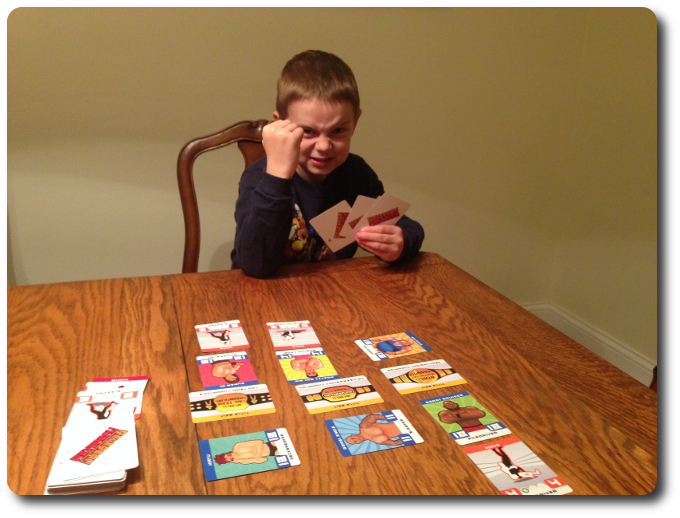
This game brought out the worst and the best in the Child Geeks…
The Parent Geeks also enjoyed the game, both with their peers and with their opposing family members. According to one Parent Geek, “There’s a lot more to this game than you realize when you first play it. You have to do much more thinking than I thought was necessary.” Another Parent Geek said, “I think the most brilliant part about this game is how much choice it gives you without really swamping the player with decisions.” In fact, the number of choices to be made was sometimes seen as a stresser, as there were lots of good options, but a player can only play 2 cards on their turn. As one Parent Geek put it, “Sometimes the most difficult thing about this game is simply deciding what is the most beneficial out of a lot of beneficial things.” When all the matches were over, Reversal! won the Title Belt with the Parent Geeks.
The Gamer Geeks were mixed. A number of them believed that Reversal! was a good example of how to design a 2-player game in a way that required some serious thinking. According to one Gamer Geek, “I’m very impressed with the game. It has a lot more depth than I thought it would and there are some very meaningful choices to be made, both in the long-term and immediately on a player’s turn.” The Gamer Geeks that supported the game praised it as a great candidate for a game filler, remarking how easy it would be to travel with the game. The Gamer Geeks who did not care for the game focused more of the game play, remarking that it didn’t feel like a wrestling match, but rather an exercise in math. According to one Gamer Geek, “I think the game play is fine, but it all comes down to just adding numbers. That’s boring, even though I can move numbers around and modify them.” Another Gamer Geek said, “I played the game once and I don’t think I need to play it again. It’s going to be the same thing each time.” While the Gamer Geeks disagreed on the level of approval Reversal! should receive from the elitists, they all agreed that the designer missed the boat by making all the Title Belts the same. One Gamer Geek said, “It would have been better if each Title Belt had its own special rules or restrictions.” A very interesting idea!
Reversal! was surprisingly entertaining and had just enough depth to keep me interested from the very first card to the very last. It’s note a game I could play multiple times back to back, due to the game’s depth and strategy being limited to the random cards a player is dealt, but each game was different, felt like a fresh challenge, and had some outstanding upsets. For example, a tied game between two players was coming down to the last match to determine the winner. In a desperate move, Player A used a Move card with a huge Modifier against his opponent. Player B just happened to draw the Reversal card and grabbed her opponent’s last Move which also happened to be her Wrestler card’s special finishing move! BOOM! The game was over after a spectacular display of the proverbial tables being turned.
Reversal! has a lot of moments like this, which might be the biggest reason why it was so enjoyed. It’s impossible to predict how a match might turn out until the very end. This kept everyone on their toes. But such drama can also take its toll on a player, causing them to feel rather exhausted after a single game. Which is also another reason why I think so many of our players mentioned it’s a game they would enjoy playing, but not all the time.
I would categorize Reversal! as a “game filler”. It’s not heavy enough to be the main event, but it has more than enough action to be a pleasant and worthwhile distraction between games or waiting to start a game. I always enjoy games like this because they are the equivalent to snacks. Something small to tide you over until you can sink your teeth into something more meaty. Reversal! does this perfectly, challenging players to consider proper timing, where to focus their attention, manage their cards to collect combos, and balance the actions and reactions to claim the Title Bout cards. It all comes together nicely and is so very easy to learn. Winning is another matter, especially when you are evenly matched against an opponent that has the cards and skills to make you work hard for your victory.
I’m very pleased with Reversal! I didn’t have much in the way of expectations, but I was still surprised and delighted. It’s not that I set the bar low, it’s that I had no real idea where to place the bar to begin with. Reversal! has set its own bar and its pretty high. For a 2-player game, it’s great for a filler or just a quick couple of games with a friend who you want to thematically smash into the canvas floor with a reverse elbow strike. Reversal! is a game you should get into the ring with.
This game was given to Father Geek as a review copy. Father Geek was not paid, bribed, wined, dined, or threatened in vain hopes of influencing this review. Such is the statuesque and legendary integrity of Father Geek.



